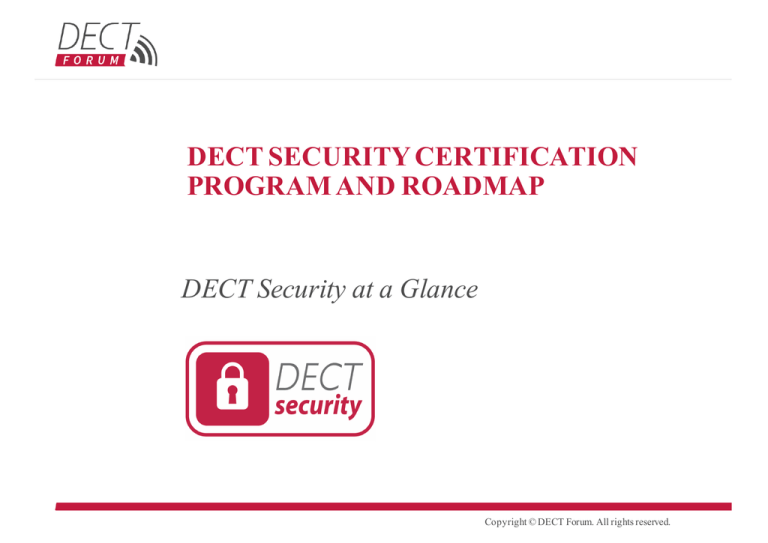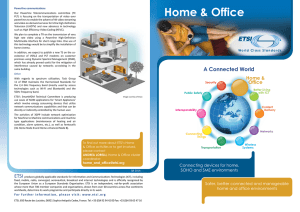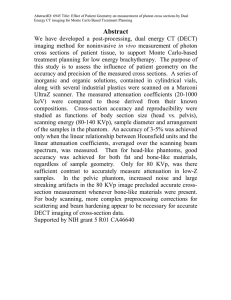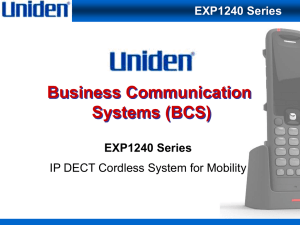
DECT SECURITY CERTIFICATION
PROGRAM AND ROADMAP
DECT Security at a Glance
Copyright © DECT Forum. All rights reserved.
INTRODUCTION
•
The security aspects in the DECT standard have been improved after concerns were
raised in the market since early 2009
•
The DECT Forum Security Working Group has worked closely with deDECTed.org, who
were instrumental in raising the concerns and providing their expertise on the legacy
security mechanisms
•
Security enhancements are being introduced in a step-wise manner to address immediate,
mid-term and long-term concerns
•
Over the past years the DECT Forum has developed a certification program that is being
launched at the annual DECT Conference
•
This presentation will provide an overview of the certification program and also touches
upon the future steps in the DECT Security Roadmap
Copyright © DECT Forum. All rights reserved.
DECT SECURITY ROADMAP
•
STEP A:
§ Improvement of the DECT standard to rectify a number of security weaknesses
§ Step A was ratified by ETSI early 2010
•
STEP B:
§ Improvement of the authentication algorithm
§ The improved algorithm is called DECT Standard Authentication Algorithm 2
(DSAA2) was published during 2012
•
STEP C:
§ Improvement of the encryption algorithm
§ The improved version is called DECT Standard Cypher 2 (DSC2)
§ Introduction time of Step C is not yet decided
Copyright © DECT Forum. All rights reserved.
SECURITY FEATURES – STEP A
Feature
• DECT GAP
has been
enhanced with
the new
Security
features
DECT
GAP
DECT
Security
Registration procedure and time limits for setting of a44 bit
O
M
"Encryption activation FT initiated" (Base & Handset)
Note : all voice calls encrypted
O
M
On air key allocation (Base & Handset)
O
M
Authentication of PP (Base & Handset)
O
M
Evaluation of peer sides behavior regarding encryption including
timeout values for triggering of call release
O
M
Early encryption
O
M
Procedure for re-keying with a new derived cipher key during a
call
O
M
Note: M = Mandatory, O = Optional
Copyright © DECT Forum. All rights reserved.
SECURITY FEATURES – CAT-iq
• Security
features have
also been
incorporated
into the
CAT-iq profile
specifications
Feature
CAT-iq
2.0
CAT-iq
2.1
Registration procedure and time limits for setting of a44 bit
M
M
"Encryption activation FT initiated" (Base & Handset)
Note : all voice calls encrypted
M
M
On air key allocation (Base & Handset)
M
M
Authentication of PP (Base & Handset)
M
M
Evaluation of peer sides behavior regarding encryption including
timeout values for triggering of call release
M
M
Early encryption
O
M
Procedure for re-keying with a new derived cipher key during a
call
O
M
Note: M = Mandatory, O = Optional
Copyright © DECT Forum. All rights reserved.
SECURITY FEATURES – CAT-iq
Feature
Registration procedure and time limits for setting of a44 bit
"Encryption activation FT initiated" (Base & Handset)
Note : all voice calls encrypted
References within the ETSI Standard
EN 300 444
Feature N.35
§8.45.4 Subscription requirements
Feature N.17 / N.35
§8.33 Cipher-switching initiated by FT
§8.45.1 Encryption of all calls
On air key allocation (Base & Handset)
Feature N.12
§8.32 Key allocation
Authentication of PP (Base & Handset)
Feature N.9
§8.24 Authentication of PP
Evaluation of peer sides behaviour regarding encryption including
timeout values for triggering of call release
Early Encryption
Procedure for re-keying with a new derived cipher key during a
call
Feature N.35
§8.45.5 Enhanced security regarding legacy
devices
Feature N.35
§8.45.3 Early encryption
Feature N.35
§8.45.2 Re-keying during a call
Copyright © DECT Forum. All rights reserved.
WHAT DO THESE FEATURES MEAN?
•
Registration procedure and time limits for setting of a44 bit
The base station will not be kept “open for registration” for longer than 120 seconds
•
"Encryption activation FT initiated" (Base & Handset)
The base station and handset will support encryption activation, and the base will
activate it for all
calls (including voice calls, List Access sessions, SUOTA/ Light data
services, etc.)
•
On-air key allocation (Base & Handset)
The base station will create and allocate a (64 bit) authentication key (UAK) when the
handset is registered
•
Authentication of PP (Base & Handset)
The base can authenticate the handset (utilizing its UAK), to ensure it is the genuine handset, and not
an intruder or an attempt to imitate the real handset.
§
NOTE: the combination of authentication and encryption convey the principle of
“mutual authentication”, by which each side is assured that the other side is genuine
Copyright © DECT Forum. All rights reserved.
WHAT DO THESE FEATURES MEAN?
•
Evaluation of peer sides behavior regarding encryption including timeout values
for triggering of call release
§ If the peer behaves differently as expected, e.g. it doesn’t initiate encryption in a timely manner,
then the device will assume it is an attempt to breach security and the call will be dropped
•
Early encryption
§ Guarantees encryption activation immediately after connection establishment, before any higher
layer protocol messages are exchanged (including Caller ID, dialed digits, etc.)
•
Procedure for re-keying with a new derived cipher key during a call
§ The cipher key used by the encryption engine is updated at least once per 60 seconds, to foil any
attempt to crack the ciphering by brute-force techniques e.g. like super computing
Copyright © DECT Forum. All rights reserved.
RELEVANT SPECIFICATIONS
•
The security requirements that DECT devices need to comply with are defined
in the document “DECT Security Feature Requirements”, available on DECT
Forum’s website
•
Current applicable standard for Security features:
ETSI TS 102 841 V1.2.1 (DECT Security “Step A”)
•
The applicable test specifications can be found under:
ETSI TS 102 841, GAP.N.35
Copyright © DECT Forum. All rights reserved.
BACKGROUND AND GOALS
The DECT Security Certification Program:
• Evaluation of peer sides behavior regarding encryption including timeout values for
triggering of call release
•
The certification program makes it possible for full members of the DECT Forum to
obtain formal certification for their products to confirm that they are compliant with the
latest status of the DECT standard
•
The certification program enables vendors to promote to their customers that their DECT
products meet the latest DECT Security standards
•
DECT Forum has defined a DECT Security roadmap in 3 steps (A, B and C). Current
requirement level for certification is “Step A”
•
The level of security (step A, B, or C) that specific DECT Security certified devices are
compliant with will be published on the DECT Forum website
Copyright © DECT Forum. All rights reserved.
PRECONDITIONS FOR
CERTIFICATION
DECT Security is a registered trademark owned by the
DECT Forum, it references features and procedures to
corresponding ETSI Specifications.
Only end products
can be approved through
the certification program
(fixed part and/or
portable part)
DECT Security
Certification
Program
Only
FULL MEMBERS
of the DECT Forum
can apply for
certification
Note*: Presenting company must be a Full Member of DECT Forum, a semiconductor chip-set supplier ,
design house or an operator member cannot be claimed as the FULL member.
Copyright © DECT Forum. All rights reserved.
REGULATIONS
•
To enter certification program
§ Must be a FULL member of the DECT Forum, cannot use supplier e.g. chipset supplier, design
partner or end customer e.g. operator as the member company
•
Rights to use the logo on end product
§ FULL member who applied for and achieved certification
§ Manufacturer/brand placing the product in the market, with a certificate from a FULL member
in their supply chain. Said manufacturer/brand must be an Associate or FULL member of the
DECT Forum
§ Operator placing the product in the market, with a certificate from a FULL member in their
supply chain. Said operator must be an Associate or FULL member of the DECT Forum
•
Right to use the logo on promotional material
§ FULL member of the DECT Forum
Copyright © DECT Forum. All rights reserved.
CERTIFICATION LEGAL FRAMEWORK DOCUMENTS
•
DECT Security Qualification Program Regulation:
overall definition of the Certification Program
•
DECT Security Certification Agreement (Bodies):
agreement between DECT Forum and a Qualification Body by which DECT Forum appoints the Qualification
Body to assess Products for certification on the basis of a test report provided by a Qualification Laboratory
•
DECT Security Testing Agreement (Independent Lab & Manufacturer Lab):
agreement in which DECT Forum appoints an organization as a Qualification Laboratory to assess and test
products submitted by Full Members
•
DECT Security License Agreement:
agreement between DECT Forum and the Licensee, granting the right to use the registered DECT Security
picture mark
•
DECT Security Feature Requirements:
specifies the requirements that DECT devices need to comply with in order to be certified
•
DECT Security Measurement Specifications:
details the measurement requirements for the DECT Security compliance tests
Copyright © DECT Forum. All rights reserved.
CERTIFICATION PROCESS FLOW (1)
Pre-Testing
Request for Certification
Register Certification
Definition of Test Campaign
Is testing
required ?
NO
YES
Testing Services request
Testing Service Agreement
Testing Process
Security
Qualification
Laboratory
Security
Qualification
Body
Test Report
Assessment & Notification
Store
Assessment
&
Notification
Assessment & Notification
Compilation of Technical Construction File
Assessment
of Technical
Construction
File
Application
Manufacturer
/Brand
Copyright © DECT Forum. All rights reserved.
CERTIFICATION PROCESS FLOW (2)
Archives
Technical
Construction
File
Application for Certificate
Requests License Fee
Requests License Fee
Requests License Agreement
Pays License Fee
Manufacturer
/Brand
Signs License Agreement
Security
Qualification
Body
Sends License Fee &
Signed Agreement
Assigns Certificate No
Adds to List
of Verified
Products
Issues Certificate
Archives
Certificate
Copyright © DECT Forum. All rights reserved.
CERTIFICATION LICENSE STRUCTURE (I)
•
A License Fee is payable to the DECT Forum prior to issuing the certificate.
DECT Forum will use the fees generated from the Qualification Program to
contribute to the protection of the DECT Security trademark.
•
Original License
§ 1,500 CHF per set (handset/headset and base)
§ 1,000 CHF per single device
•
Re-testing License
§ Original ODM/OEM Product has been certified already
§ Product is sold with DIFFERENT software, but only if the differences in the software
affect the DECT Security aspects of the product
§ 750 CHF per set (handset/headset and base)
§ 500 CHF per single device
Copyright © DECT Forum. All rights reserved.
CERTIFICATION LICENSE STRUCTURE (II)
•
Branding License
§
§
§
§
Original ODM/OEM Product has been certified already
Product is sold in same housing & same PCB/Components under different product name
Colour variations are defined as same housing
Software changes in MMI/GUI are allowed (icons or text) but no changes that affect
the DECT Security aspects of the product
§ 500 CHF per set (handset/headset and base) or single device
•
Logo Usage License
§
§
§
§
§
Original ODM/OEM Product has been certified already
Product is sold in same housing and SAME PCB/Components under different product name
Colour variations are defined as same housing
No software changes other than in MMI/GUI allowed (icons or text)
No additional fee
Copyright © DECT Forum. All rights reserved.
FEATURE REQUIREMENTS AND TEST EQUIPMENT
•
•
•
•
The security requirements that DECT devices need to comply with are defined in the document
“DECT Security Feature Requirements”, available on DECT Forum’s website (www.dect.org)
Current applicable test standard for Certification: ETSI TS 102 841 V1.2.1 (DECT Security “Step
A”)
Only protocol component testing is required for the security certification, hence no requirements for
additional testing in other regions, security certification can be re-used
Security Test equipment available from Dosch&Amand:
§ DA1220S
DECT Security Test System
§ DA1220-B32
Software option to current DA1220 GAP
system to test all ”Step A” security features
§ DA1220-B31
Software option to current DA1220 CAT-iq 2.0 system
to test the security features included in CAT-iq profiles
Copyright © DECT Forum. All rights reserved.
DECT SECURITY ROADMAP
•
The following further steps have been defined:
§ Step B - DSAA2: improved authentication algorithm based on AES
§ Step C - DSC2: improved encryption algorithm based on AES
•
Standardization of DSAA2 and DSC2:
§ ETSI has completed & published the standardization
•
Certification of DSAA2 (Step B):
§ Depends on market interest
§ Requires substantial effort for writing test scripts and developing the test equipment.
•
Certification of DSC2 (Step C):
§ Depends on market interest and availability of chipsets
Copyright © DECT Forum. All rights reserved.
REGISTERED DECT SECURITY LOGO
DECT Security is a registered trademark owned by the DECT Forum
DECT Security is a trademark which is only licensed for use on cordless
handsets and base stations which meet DECT Forum certification
requirements;
“DECT” is a registered mark in the name of the European Telecommunications
Standards Institute (ETSI) - European Community Trademark Registration
No. 981753;
Copyright © DECT Forum. All rights reserved.
CERTIFICATION CONTACTS
CETECOM
Marco Lenjoint
CETECOM ICT Services GmbH
Untertuerkheimer Str. 6-10
D-66117 Saarbruecken - Germany
Marco.Lenjoint@cetecom.com
T: +49 (0) 681 5 98 8317
Nemko
Frode Sveinsen
Nemko AS
Instituttveien 6, 2007 Kjellet - Norway
sveinsenfr@nemko.com
T: +47 6484 5700
Dosch & Amand
Dr. Franz Dosch
Dosch & Amand Research GmbH Co. KG
Neumarkter Str. 18, D-81673 Munich - Germany
franz.dosch@da-research.de
T: +49 (89) 3589 85 10
Copyright © DECT Forum. All rights reserved.
MORE INFORMATION
•
More information about DECT Security: www.dect.org
•
For direct enquiries:
DECT Forum Secretariat
Wabernstr. 40
3007 Bern, Switzerland
+49 89 51662456
+49 176 2535 0007
secretariat@dect.org
@ DECT_Forum
Copyright © DECT Forum. All rights reserved.




